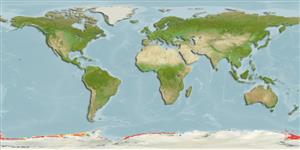>
Perciformes/Notothenioidei (Icefishes) >
Artedidraconidae (Barbled plunderfishes)
Etymology: Artedidraco: Petrus (Peter) Artedi, (10 Mar.) 1705-35 (28 Sep.), a son of a clergyman from Anundsjö named Olaus Arctaedius, in the northern part of Sweden.In 1729 he changed his name from Arctaedius to Arctædi, a name still later simplified to Artedi (Ref. 45335).
More on author: Regan.
Environment: milieu / climate zone / depth range / distribution range
Ecología
marino demersal; rango de profundidad 82 - 801 m. Polar; 66°S - 77°S
Southern Ocean: East Antarctica (Ross Sea, South Victoria Land, Weddell Sea).
Tamaño / Peso / Age
Maturity: Lm ? range ? - ? cm
Max length : 15.2 cm TL macho / no sexado; (Ref. 124149); 16.7 cm TL (female); peso máximo publicado: 38.00 g (Ref. 124149); peso máximo publicado: 38.00 g
Found on the sublittoral and continental shelf. Feeds mainly on gammaridean amphipods, with substantial amounts of errant polychaetes. Isopods were a minor food item.
Life cycle and mating behavior
Maturities | Reproducción | Spawnings | Egg(s) | Fecundities | Larva
Eakin, R.R., 1990. Artedidraconidae. p. 332-356. In O. Gon and P.C. Heemstra (eds.) Fishes of the Southern Ocean. J.L.B. Smith Institute of Ichthyology, Grahamstown, South Africa. (Ref. 5181)
IUCN Red List Status (Ref. 130435)
Threat to humans
Harmless
Human uses
Pesquerías: sin interés
Herramientas
Special reports
Download XML
Fuentes de Internet
Estimates based on models
Preferred temperature (Ref.
123201): -1.8 - 0.3, mean -1 °C (based on 290 cells).
Phylogenetic diversity index (Ref.
82804): PD
50 = 0.5156 [Uniqueness, from 0.5 = low to 2.0 = high].
Bayesian length-weight: a=0.00537 (0.00340 - 0.00847), b=3.27 (3.13 - 3.41), in cm total length, based on LWR estimates for this species & (Sub)family-body (Ref.
93245).
Nivel trófico (Ref.
69278): 3.2 ±0.45 se; based on food items.
Resiliencia (Ref.
120179): Medio, población duplicada en un tiempo mínimo de 1.4-4.4 años (Assuming fec > 100).
Fishing Vulnerability (Ref.
59153): Low vulnerability (10 of 100).
